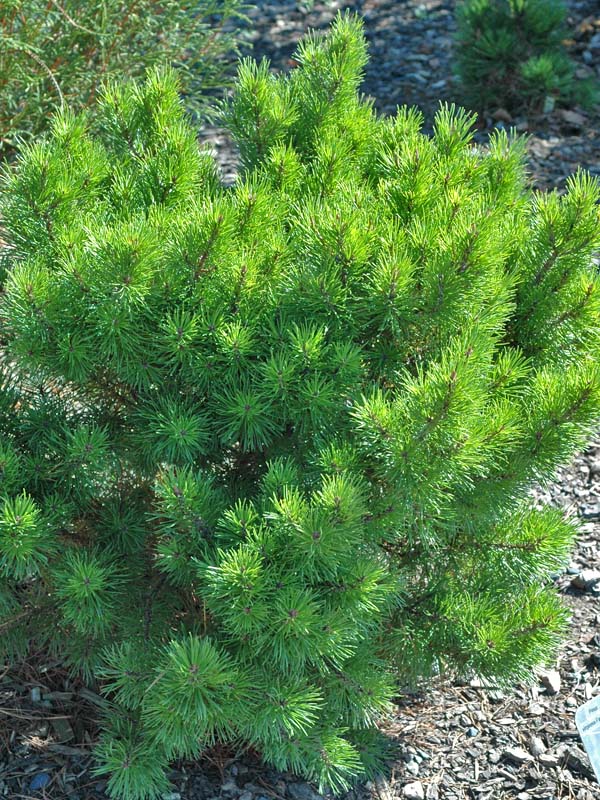
Woody > Pinus > Pinus virginiana > Pinus virginiana
Pinus virginiana
Virginia Pine, Jersey Pine, Spruce Pine, Scrub Pine
Origin: The United States of America.
Mike's
Opinion


"
Pinus virginiana grows well in poor, dry soil and is often used for reforestation purposes. Once called a "forest weed" or "scrub pine", it is now frequently used as a Christmas tree. This fine textured tree grows extremely well in full sun and poor soils.
Michael Pascoe, NDP., ODH., CLT., MSc. (Plant Conservation)
"
| Family |
| Pinaceae |
| Genus |
| Pinus |
| Species |
| virginiana |
| Category |
| Woody |
| Type |
| Tree (evergreen) |
| Pronunciation |
| USDA Hardiness Zone |
| 6 |
| Canadian Hardiness Zone |
| 5a - 6a |
| RHS Hardiness Zone |
| H6 - H7 |
| Temperature (°C) |
| -30 |
| Temperature (°F) |
| -23 |
| Height |
| 9 - 18 m |
| Spread |
| 6 - 10 m |
Photographs
Description and Growing Information
Flowering Period
| General Description |
| Pinus virginiana is a scrubby evergreen tree with yellow / green, flexible needles and long, horizontal branches and a relatively short trunk covered with orange-red bark. |
| Landscape |
| A relatively fast growth rate makes it very good for reforestation where clear cutting or fire has occurred. |
| Cultivation |
| Grows best in clay, loam or sandy soils with a pH of 4.5 - 7.5. Suited to well drained soils and less tolerant of wet sites. It is very drought and salt tolerant and grows well in course to medium textured soils. |
| Shape |
| The crown shape is round with irregular uniformity making it fairly sparse and unsightly. |
| Growth |
| Medium |
| ID Characteristic |
| Younger trees have orange-brown bark covered with thin scaly plates that turns orange-red and more rigid as the tree matures. |
| Pests |
| No serious pests or diseases of note. |
| Habitat |
| Grows naturally in poor, dry soils at elevations of 15 - 760 m. Does not grow well in shallow, chalky soils with too much water. It can be found growing in abandoned farmlands and in places where forest fires have occurred. |
| Bark/Stem Description |
| Young bark is smooth and reddish in colour that matures into shaggy, scaly textured, brown-orange bark that tends to be quite thick. |
| Flower/Leaf Bud Description |
| Conical and acuminate with dark brown, resinous scales ranging from 0.8 - 1.3 cm in length. |
| Leaf Description |
| There are two needles per fascicle in a dark grayish-green colour. They range from 4.1 - 7.1 cm in length and are rigid and often twisted. |
| Flower Description |
| Monoecious with male flowers yellow and cylindrical and female flowers yellow-red and curved. |
| Fruit Description |
| Range from 3.8 - 6.4 cm in length with conical to ovoid cones covered in brown-red scales. |
| Colour Description |
| Foliage stays green throughout the seasons. The fruit is brown and twigs have a reddish colour. |
| Texture Description |
| Tends to be a finely textured tree in the early stages, becoming more rough and scaly as it matures. |
| Notable Specimens |
| The Arnold Arboretum, Boston, Massachusetts, United States of America. Westonbirt, The National Arboretum, Tetbury, Gloucestershire, England. |
| Propagation |
| By seed: cold stratification is required as well as soaking for 24 hours and exposure to full sunlight before sowing. Seedlings need relatively dry soil; growth decreases without proper amounts of magnesium and potassium. Grafting is also possible but there tends to be only a 65% success rate with this method. |
References
Collingwood, G. H., Warren David Brush, and Devereux Butcher. Knowing Your Trees. Washington: American Forestry Association, 1978/1979. Print.
Kellison, R. C., and Bruce Zobel. Genetics of Virginia Pine. Washington, D.C.: U.S. Deptartment of Agriculture, 1974. Print.
Meyer, Frederick G., and Peter M. Mazzeo. A Catalog of Cultivated Woody Plants of the Southeastern United States. Washington, D.C.: U.S. Dept. of Agriculture, Agricultural Research Service, 1994. Print.
